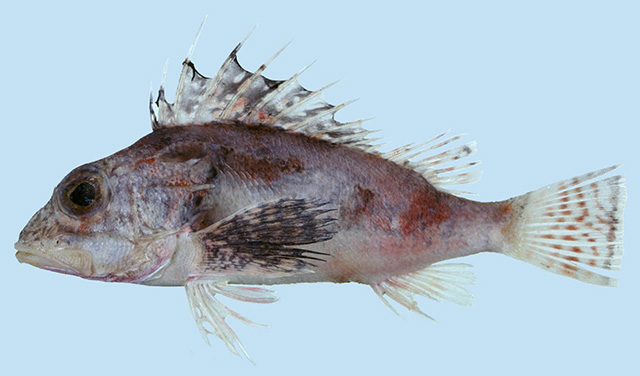| Neosebastidae (Gurnard scorpionfishes) |
| 16.9 cm SL (male/unsexed) |
|
demersal; marine; depth range 170 - 250 m |
| Eastern Indian Ocean: Off northwestern coast of Western Australia. |
|
Dorsal spines (total): 8-8; Dorsal soft rays (total): 8-8; Anal spines: 3-3; Anal soft rays: 5-5. Diagnosis: Underside of mandible with numerous tiny pores, no ridges. Preocular spine usually simple, and flattened anteriorly and posteriorly; supraocular spines occurring only posterior to vertical midline of eye; no additional spines between lacrimal and suborbital ridges; upper opercular spine simple. Midinterorbital space covered with scales; interorbital space shallow, becoming shallower with growth. Pored lateral-line scales 34-36 (mode 35); longitudinal scale rows 57-63 (57). Pectoral-fin rays 20-22 (21); pectoral fin short (2.9-3.5, mean 3.2 in SL), not reaching a vertical at origin of last dorsal-fin spine. Posterior margin of maxilla not reaching a vertical at posterior margin of pupil. Snout length long (3.5-4.0, 3.7 in HL); interorbital width wide (5.2-6.7, 5.7 in HL); body depth shallow (2.8-3.4, 3.1 in SL). Bilobed portion of swimbladder less than half of total swimbladder length. There are no distinct small black spots on head or lateral line (Ref. 54394). |
| Found on the continental shelf and continental slope (Ref. 75154). Most specimens taken in trawls have sand grains inside the mouth indicating occurrence on open, predominantly sandy substrata (Ref. 54394). |
|
Not Evaluated (N.E.) Ref. (130435)
|
| harmless |
Source and more info: www.fishbase.org. For personal, classroom, and other internal use only. Not for publication.
